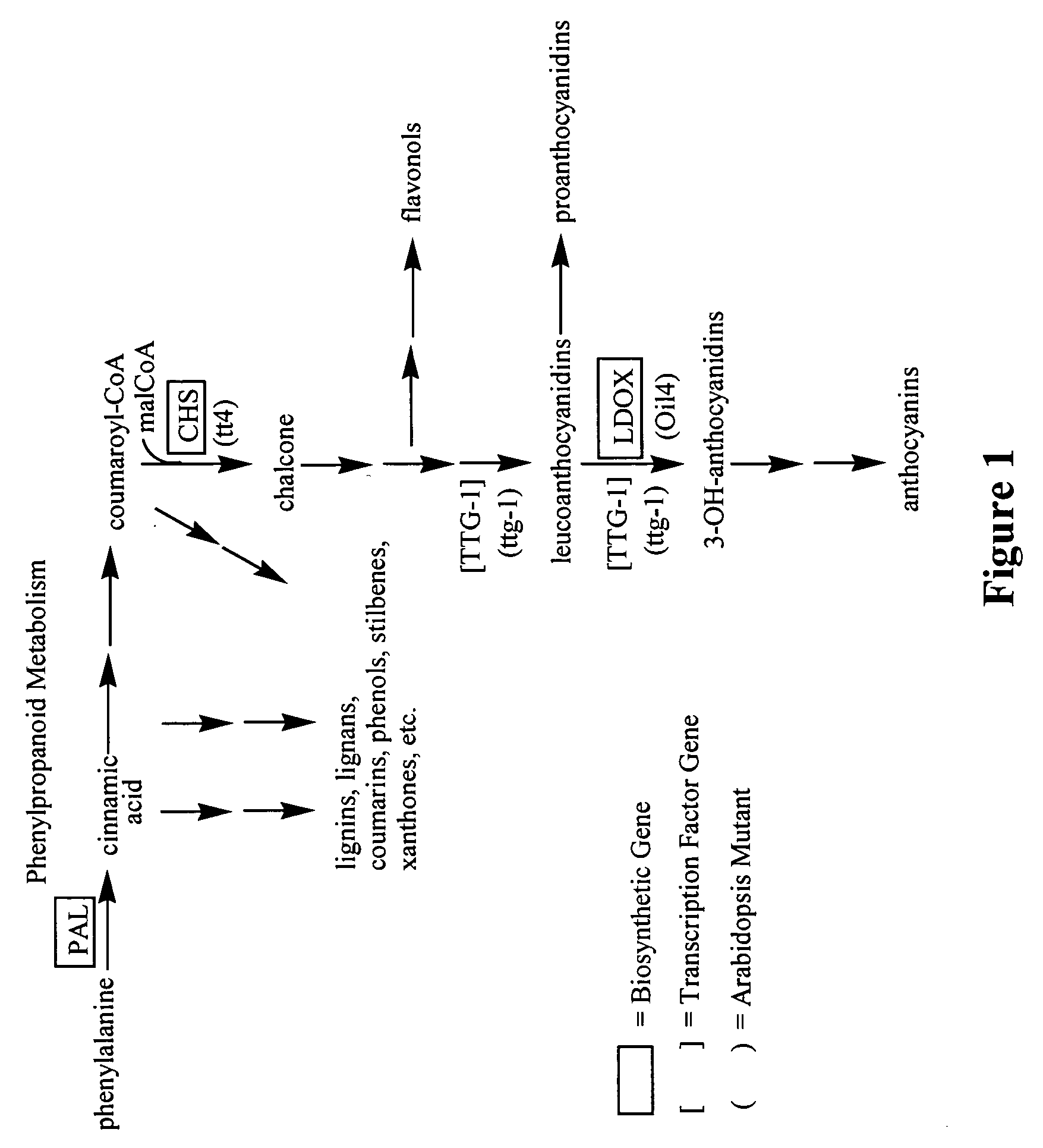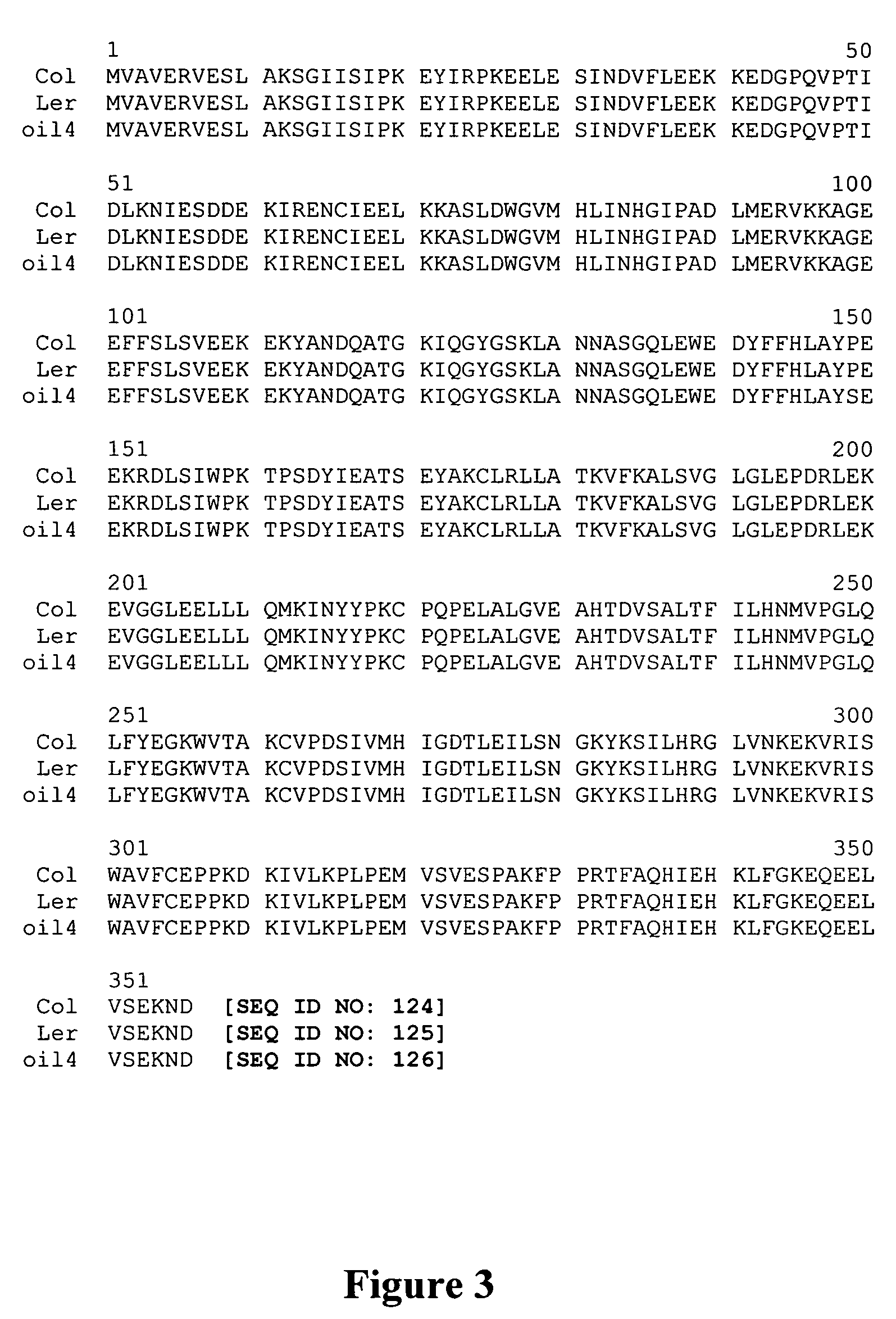Production of increased oil and protein in plants by the disruption of the phenylpropanoid pathway
a technology of phenylpropanoid pathway and plant oil, which is applied in the direction of plant products, peptides, enzymology, etc., can solve the problems of not increasing the oil content in these experiments, and achieve the effects of increasing the oil content of a plant, disrupting the function of the phenylpropanoid pathway protein, and increasing the oil content of the plan
- Summary
- Abstract
- Description
- Claims
- Application Information
AI Technical Summary
Benefits of technology
Problems solved by technology
Method used
Image
Examples
example 2
[0160] This example describes the construction of plant transformation vectors with the BnCHS and BnTTG1 coding sequences described above.
[0161] pMON75051 (e35S::BnCHS(antisense)::tml)
[0162] A 3470-base pair fragment containing the e35S promoter, the BnCHS (SEQ ID NO: 33) in antisense orientation and the tml 3' UTR was removed from the vector KAHADF032096 by digestion with NotI. The fragment was ligated into the vector pCGN11121, which had been digested with NotI. The vector pCGN11121 contains a nopaline T-DNA right border sequence and octopine T-DNA left border sequence, in between which are the promoter from the Figwort Mosaic Virus (FMV) and the intron from Z. mays HSP70 driving the expression of the CP4 EPSP synthase gene containing a CTP, linked to a synthetic EPSP synthase coding region and the 3' UTR from the pea rbsc E9 gene and the recognition sites for the recombinase. The resulting plasmid was named pMON75051. The nucleic acid sequence was determined using standard sequen...
example 3
[0183] This example describes the transformation of canola and Arabidopsis plants.
[0184] Arabidopsis Transformation
[0185] Arabidopsis seeds, mutant and wild type, are sown onto 21 / 4 inch pots containing reverse osmosis water (ROW) saturated MetroMix 200 (The Scotts Company, Columbus, Ohio).
[0186] The plants are vernalized by placing the pots in a flat, covered with a humidity dome, in a growth chamber at 4-7.degree. C., 8-hrs light / day for 4-7 days. The flats are transferred to a growth chamber at 22.degree. C., 55% relative humidity, and 16-hrs light / day at an average intensity of 160-200 .mu.Einstein / s / m.sup.2. After germination, the dome is lifted and slid back about 1 inch to allow for mild air circulation without desiccation. The humidity dome is removed once true leaves have formed. The plants are bottom watered, as needed, with ROW until well established, generally 2-3 weeks after germination. Plants are then bottom watered, as needed, with Plantex 15-15-18 solution at 50 ppm...
example 4
[0197] This example describes the analysis of transformed plants for oil and protein levels in the seed.
[0198] Oil levels in Arabidopsis seed tissues are established by near-infrared reflectance (NIR) spectroscopy (Williams and Norris (eds.), Near-infrared Technology in the Agricultural and Food Industries, American Association of Cereal Chemists, Inc., St. Paul (1987)), whereby NIR spectra of pooled seed samples harvested from individual plants are measured, and oil levels are calculated based on regression analysis using a standard curve generated from analysis of Arabidopsis seed with varying oil levels as determined gravimetrically following accelerated solvent extraction (Better Solutions for Food and Beverage Analysis, 2nd edition, Dionex Corporation, Sunnyvale, Calif. 1997).
[0199] Oil levels in canola seed are established by NIR as described above using a standard curve generated from analysis of canola seed with varying oil levels. Briefly, mature canola seeds previously dri...
PUM
| Property | Measurement | Unit |
|---|---|---|
| Fraction | aaaaa | aaaaa |
| Electrical conductance | aaaaa | aaaaa |
| Electrical conductance | aaaaa | aaaaa |
Abstract
Description
Claims
Application Information
 Login to View More
Login to View More - R&D
- Intellectual Property
- Life Sciences
- Materials
- Tech Scout
- Unparalleled Data Quality
- Higher Quality Content
- 60% Fewer Hallucinations
Browse by: Latest US Patents, China's latest patents, Technical Efficacy Thesaurus, Application Domain, Technology Topic, Popular Technical Reports.
© 2025 PatSnap. All rights reserved.Legal|Privacy policy|Modern Slavery Act Transparency Statement|Sitemap|About US| Contact US: help@patsnap.com



